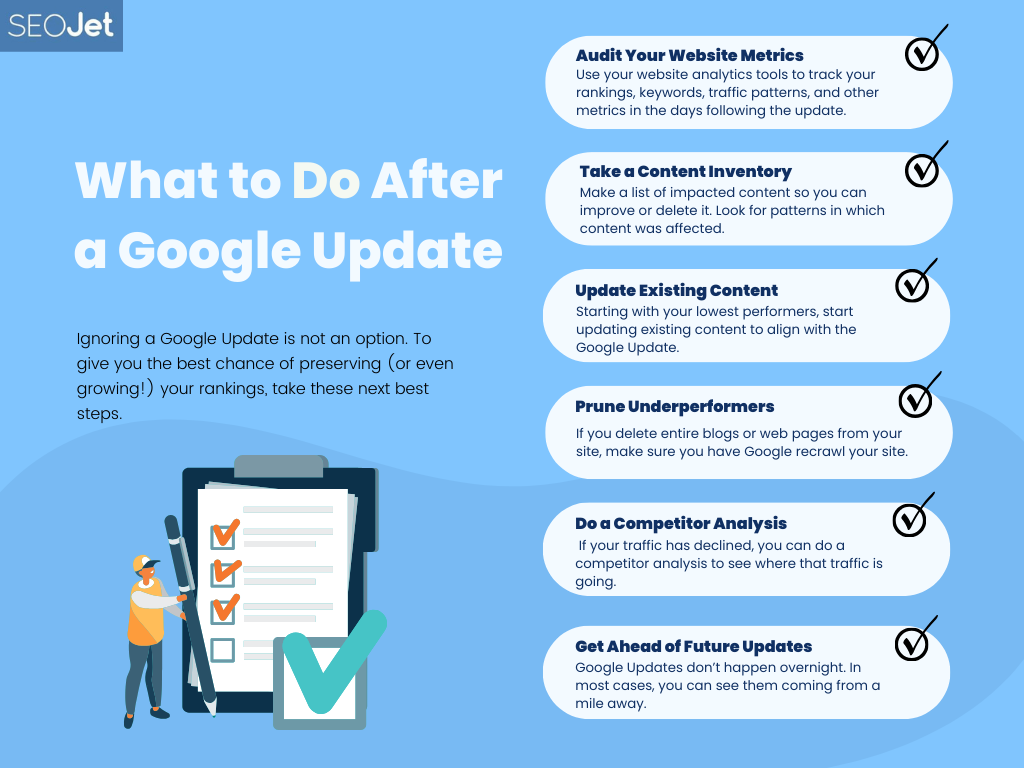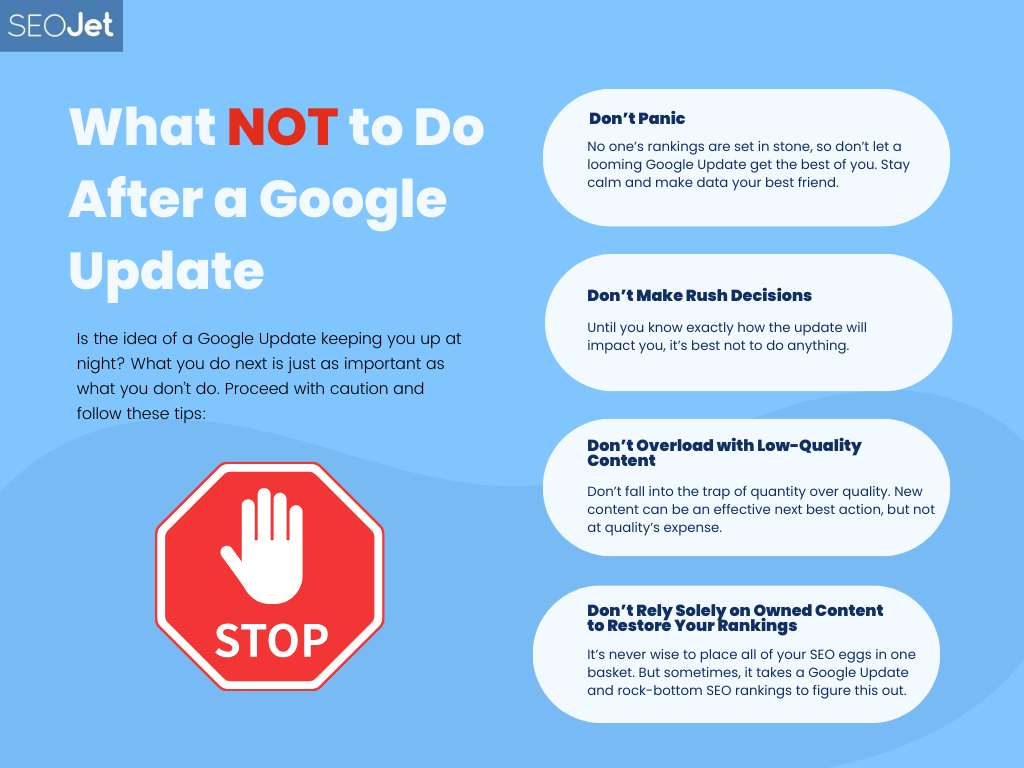SEO Case Study: How Sproutbox Increased Their Client Successes While Saving Time+Money
SEO Case Study: How Sproutbox Increased Their Client Successes While Saving Time + Money Sproutbox,
Home » Google Update Do’s and Don’ts: How to Navigate a Mission-Critical Algorithm Change

SEO Case Study: How Sproutbox Increased Their Client Successes While Saving Time + Money Sproutbox,
How a Technical SEO Audit Can Boost Your Business Ever feel like you’re doing everything
4 Takeaways from the Google API Leak and What They Mean for SEO Google has
Google algorithm updates create SEO earthquakes. If your rankings have crumbled and you’re scrambling to pick up the pieces — don’t. At least not before you know these Google Update do’s and don’ts.
Google is constantly fine-tuning its algorithm to return the best results to searchers. In fact, Google made 4,275 changes to its search algorithm in 2022 alone (that’s about 13 times per day). Its reputation is at stake, so naturally Google wants to deliver only top-quality answers and options.
To do this, it occasionally makes massive overhauls to its algorithm. There’s usually a central focus like content quality, spam, or core changes.
No matter the reason, your first priority is to preserve your hard-earned rankings.
Your second priority is to know how to restore them if they plummet.
Let’s review some essential Google Update Do’s and Don’ts so you can keep reaping SEO benefits.

Ignoring a Google Update is not an option. To give you the best chance of preserving (or even growing!) your rankings, take these next best steps.
First things first: you need a clear understanding of how the Google Update affected you. Use your website analytics tools to track your rankings, keywords, traffic patterns, and other metrics in the days following the update.
Before you do this though, make sure you understand what the update intended to improve. For example, a spam update aims to eliminate spammy content from ranking in search results and expired domain abuse. A helpful content update seeks out the best content that answers questions and provides real solutions, not just content that’s well-optimized.
Knowing the purpose of the update can help you understand what to look for during your audit and why the update might have impacted you.
Your next objective is to make a list of impacted content so you can improve or delete it. Look for patterns in which content was affected. This can give you clues about what you need to fix.
To do this, look at your traffic patterns before and after the update for each piece of content (e.g., web pages, blog posts).
If your website has suffered in the update but you can’t trace it back to just a handful of types of content, there might be an issue with your site as a whole.
Starting with your lowest performers, start updating existing content to align with the Google Update.
For example, if it’s a helpful content update, you might do the following:
Once you’ve made your updates, make sure you tell Google to recrawl your website. This will help your new content get indexed faster.
Now is a good time to evaluate whether certain content still belongs on your website. In some cases, you might be better off scraping content altogether instead of trying to update it.
This is often the case when:
If you delete entire blogs or web pages from your site, make sure you have Google recrawl your site to see those pages have been removed.
Google Updates don’t discriminate. If your traffic has declined, you can do a competitor analysis to see where that traffic is going.
It’s a good idea to do a competitor analysis anyway. You might identify a new competitor or a potential threat to your rankings.
You might also see whether a previously tough competitor might have slipped. This marks the starting point of your investigation to see what they might have done wrong. You can avoid repeating their mistakes.
Keep in mind that a Google Update doesn’t affect the people searching for products and services. It impacts where you land in the rankings, so make sure you know who’s getting the traffic you want.
Google Updates don’t happen overnight. In most cases, you can see them coming from a mile away.
Keep an eye out for upcoming Google Updates so you can get ahead of them. These updates often take a while to fully roll out, which gives you time to respond accordingly.

Is the idea of a Google Update keeping you up at night? What you do next is just as important as what you don’t do. Proceed with caution and follow these tips:
If anything is constant in SEO, it’s change. No one’s rankings are set in stone, so don’t let a looming Google Update get the best of you. Stay calm and make data your best friend.
Pro-action is key in recovering from a Google Update. But until you know exactly how the update will impact you, it’s best not to do anything.
In many cases, websites see their rankings slip initially, but they may also recover on their own. You can track your website data in the days following your rankings to see where to focus your efforts.
Leave the rush decisions to your competitors. Calm, cool heads will prevail.
Content is a fundamental piece of every SEO strategy. So when your rankings slip, the knee-jerk reaction is to create more content to optimize your online presence.
More content means more keywords, more chances to rank, and more ways to earn traffic.
But “more” isn’t always the answer.
You want any new content after the update to:
The easy solution is to outsource to a content mill to create content quickly and affordably. You want to restore your rankings now, and getting a high volume of content at a low cost looks appetizing.
Don’t fall into the trap of quantity over quality. New content can be an effective next best action, but not at quality’s expense.
Make sure your outsourced partners understand your company and audience, can find effective keywords, and deliver ready-to-publish, no-fluff content with a purpose.
It’s never wise to place all of your SEO eggs in one basket. But sometimes, it takes a Google Update and rock-bottom SEO rankings to figure this out.
In many cases, content on your own website (also called on-page SEO) will anchor your strategy. But too many businesses never move beyond this.
That leaves a lot of stones unturned to help you grow or maintain your rankings.
Now is a good time to explore other ways to rank higher. For example, if you went all in blogging, you might start adding guest posts and paid ads to the mix.
Backlinks in guest posts will help you boost your website’s authority, plus they can send free traffic to your website. Your brand gets a reputation boost by appealing on other trusted websites.
Paid ads will let you bypass the rankings altogether and send you straight to the top of the SERPs. You can target your ads around keywords just like you do with your other content, then direct traffic to a specific landing page.
SEO is a huge umbrella, and content on your own website is just a small piece of it. The more you diversify your strategy, the more agile you become in recovering from Google Updates because you have other pillars to support your SEO efforts.
These Google Updates do’s and don’ts will help you become more resilient against future updates. But more importantly, remember that SEO is a long game that demands constant attention and lots of creativity.
Backlinks with SEOJet add a critical element to any SEO strategy. We help monitor your SEO profile and build links to your website to improve or maintain your rankings.
Off-page SEO like link-building takes a unique skill set, from choosing anchor text to optimizing anchor text ratios and knowing where to post your links. Our platform does the heavy lifting for you to send you straight to the top of the search results.
Watch how SEOJet works and how we can help you futureproof against Google Updates.